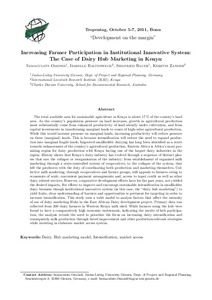Increasing farmer participation in institutional innovative system: The case of dairy hub marketing in Kenya
Abstract
The total available area for sustainable agriculture in Kenya is about 17% of the country's land area. As the country's population pressure on land increases, growth in agricultural production must substantially come from enhanced productivity of land already under cultivation, and from capital investments in transforming marginal lands to zones of high-value agricultural production. While this would increase pressure on marginal lands, increasing productivity will reduce pressure on these (marginal) lands. This is because intensification will reduce the need to expand production into marginal fragile lands. Improved smallholder dairying has long been identified as a route towards enhancement of the country's agricultural production. Eastern Africa is Africa's most promising region for dairy production with Kenya having one of the largest dairy industries in the region. History shows that Kenya's dairy industry has evolved through a sequence of distinct phases that saw the collapse or reorganisation of the industry: from establishment of organised milk marketing through a state-controlled system of cooperatives, to the collapse of the system, that left the producers with the duty of coordinating both production and marketing themselves. Collective milk marketing, through co-operatives and farmer groups, still appeals to farmers owing to economies of scale, convenient payment arrangements and, access to input credit as well as other dairy related services. However, cooperative development efforts have for the past years, not yielded the desired impacts. For efforts to improve and encourage sustainable intensification in smallholder dairy business though institutional innovative system (in this case, the “dairy hub marketing”) to yield fruits, clear understanding of barriers and opportunities is pertinent for targeting in order to increase intensification. This study uses a tobit model to analyse factors that affect the intensity of use of dairy marketing Hubs in the East African Dairy development project. Primary data was collected from 300 dairy farmers in Western Kenya milk shed. While farmers using the hub were found to have a comparatively high economic endowment, indicating the merits of hub participation, the analysis reveals the need to prioritise the focus on increasing dairy intensification and consequently milk production through breed improvement and other production-relevant strategies while investing in elaborate market access system.

